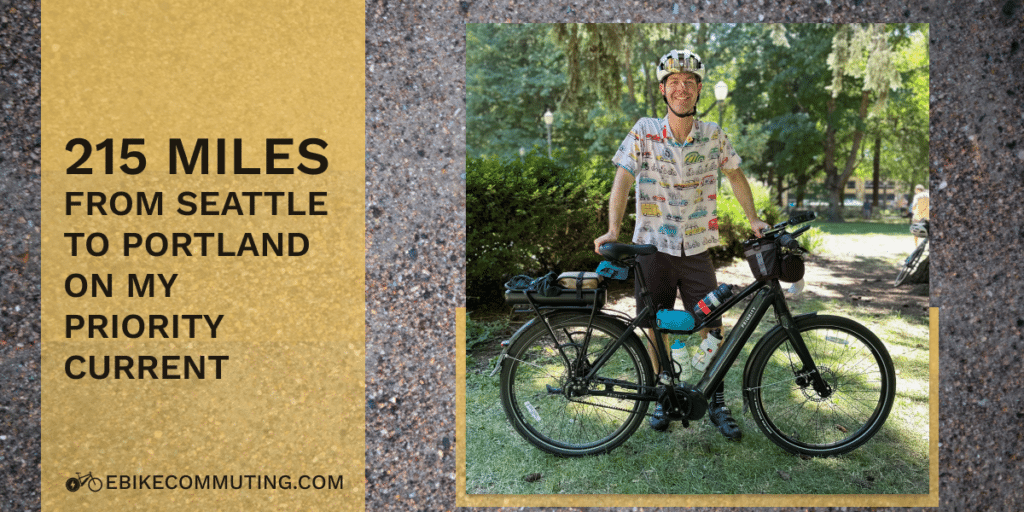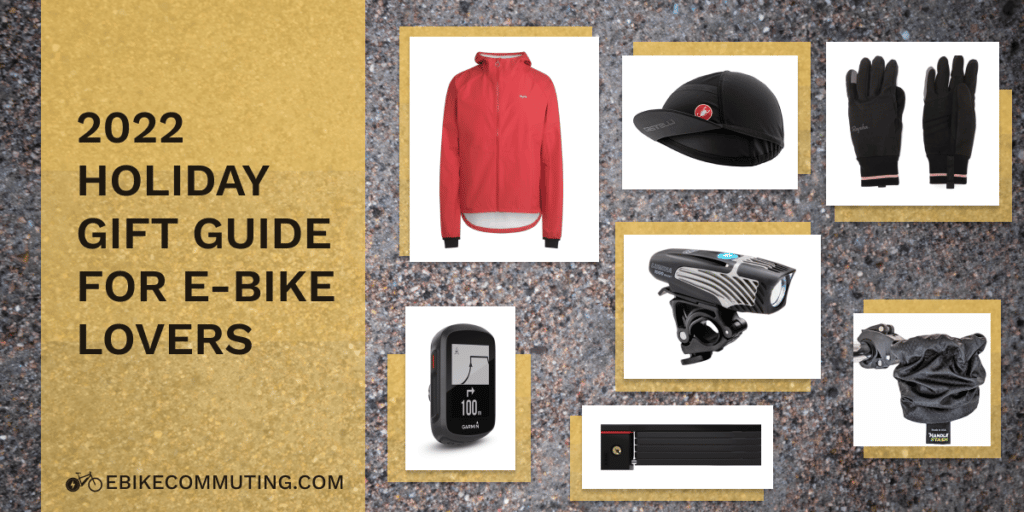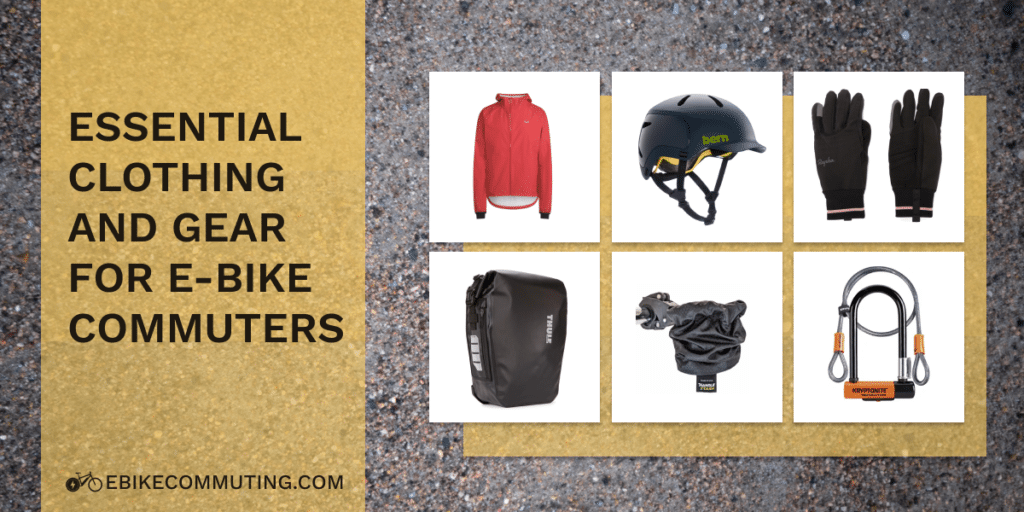Can a commuter e-bike handle a 200+ mile ride from Seattle to Portland? That was the question that started this experiment. As I wrote in my June post, earlier this year I was at a Priority Bicycles test ride event that was hosted by Cascade Bicycle Club. During my conversations with Paul Tolmé of Cascade and Connor Swegle, co-founder and CMO of Priority Bicycles, the idea formed in my head that I should try and ride the Priority Current e-bike all the way from Seattle, Washington to Portland, Oregon.
Every July for the past 44 years, Cascade has hosted their annual Seattle to Portland (STP) ride. Over the course of two days, thousands of people ride their bikes along the 206 mile route. They set off from the University of Washington, in North Seattle in the early morning hours on Saturday. With a stop in and around Centralia, Washington to spend the night, everyone sets off again on Sunday morning, aiming to reach the finish line in Portland by mid-afternoon.
I was excited to join in on this Northwest tradition and tackle the 44th edition of STP on my brand new Priority Current e-bike, little did I know that not everything would go to plan. A puncture and 9 hours on the course awaited me for the first day, but I’d go on to make a lot of new friends who enjoyed pace-lining behind my e-bike.
Table of contents
The route
The route is 206 miles long and I planned to break it up into two 100 mile days, like most riders, with an overnight stop in Centralia. However, due to the location of my hotel being 4 miles off the route my total distance for the ride ended up being 215 miles.
If you squint and look at the route’s elevation profile it almost looks like a rolling downhill from Seattle to Portland. But the route has a total elevation gain of 5,016 feet. In the grand scheme of a 215 mile ride the elevation gain isn’t that signifiant, there is only one big hill each day. The first day it comes at mile 42. The second day the hill comes at mile 11, bright and early to wake your legs up.
My goal was to average 20 miles per hour so that my time riding would only be about 5 hours each day, but with stops I guessed that my day would increase a bit. Turns out my total time on the course on Saturday would be 9 hours and 7.5 hours on Sunday. Oof, a lot longer than expected.
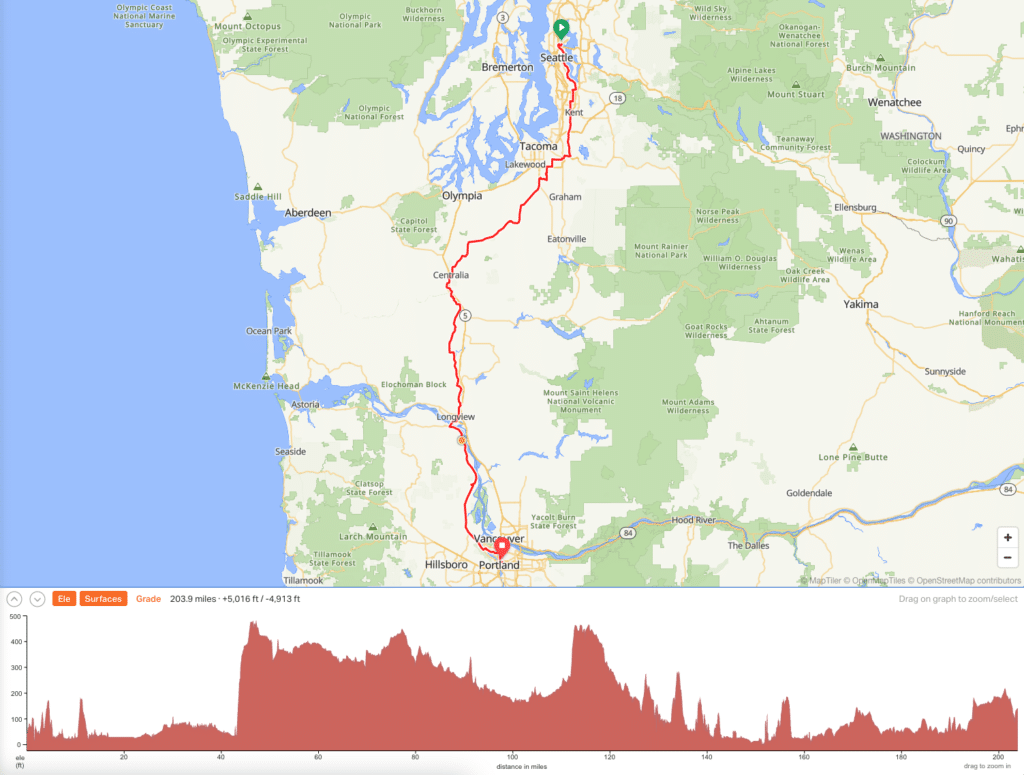
The e-bike
I chose to ride the Priority Current for the event because I’d previously reviewed it and found it be on of the best belt drive e-bike on the market. In fact, we picked it as our top belt drive e-bike for 2023. The Current is a joy to ride because of it’s powerful 500 watt mid-drive motor, quiet belt drive, and comfortable geometry.

Some of the things I like most about the Current are:
- Quality components: The Current is built with quality components and materials, which contribute to a solid ride experience and very few maintenance issues.
- Mid-drive motor with torque sensor: This is my preferred e-bike setup. The mid-drive motor provides ample power (500 watts) and when it’s paired with the torque sensor it gives you a very natural pedaling experience without any of the sudden accelerations that come with a cadence sensor.
- Belt drive with internal geared hub: I love a belt drive due to their longevity, reduced maintenance needs, and the smooth pedaling experience. The Current’s Gates Carbon belt-drive paired with an internal gear hub makes this e-bike perfect for folks commuting in rainy weather, something I often do here in Seattle 🙂
- Agility: The Current is agile and responsive making it easy to handle all sorts of terrain, including dirt & gravel trails.
- Design and aesthetics: The Current has a clean, aesthetically pleasing design with it’s battery fully integrated into the frame
I outfitted the Current with the optional rear rack and range extender. On paper this would give me about 100 miles on pedal assist level 1 (out of 5). I was a bit nervous about my fitness level and ability to ride 100 miles back to back so I asked Priority to send me two additional batteries (one frame and one range extender). This gave me the option of meeting Jody, my wife, at mile 50 each day to swap out both batteries.
Along with the two extra batteries, Priority sent me an additional charger. This would make it a bit quicker to charge the batteries when I was at the midpoint hotel.
I also utilized all three water bottle holder mounts that the newer Current comes with. Previous models only came with two water bottle mounts. With temperatures expected to reach the high 80s, I wanted to have plenty of water with me.
The biggest modification I made to the Current was that I swapped out the standard flat pedals for my mountain bike clipless pedals so that I would be more efficient when pedaling.
I also added a bell to the handlebars. This was excellent foresight because the pedal assist helped me pass a lot of people on the ride and it was nice not to have to be constantly saying “on your left.” Instead, I’d give the bell a nice little ring.
The preparation
I received the Current near the end of June, three week before STP. I assembled the Current and took it for a short ride down my street, before putting it back in my garage and telling myself I would take it out for a long ride in the coming days.
Turns out, July was a hectic month for me and I didn’t get a chance to take it out for a long test ride. Instead I took my rode bike out for a few short rides with the longest ride being 30 miles. I told myself that riding my road bike was helping ensure I had the cardio fitness to ride 200 miles.
The only ride I did with the Current before STP was a short 12 miles I did the week before STP. I did the ride without pedal assist so that I could get a sense for how the bike fit me. Throughout the ride I made tweaks to the saddle height and the handlebar position until I felt like things were in a good place. I think it was important to do this ride without power, because pedaling a 60+ lbs bike up a hill will quickly tell you if you are in a comfortable riding position or not. But, to state the obvious, only riding your bike 12 miles before a 200+ mile weekend is NOT a recipe for success. I’d highly recommend that you do more riding than I did in the months leading up to STP.
In the final few days before the big ride, I spent time mapping out a few potential meeting points with Jody near the route so that I could easily switch batteries. Having pre-agreed meeting points was key because it meant that there wasn’t a lot of back and forth on the weekend of STP. A short text from me “Meet Spanaway Safeway” and Jody immediately knew which pre-arranged meeting spot she should head to.
The other thing I did was gather all my gear for the ride and pre-pack. I wanted to make sure I could fit everything easily on the bike. Some essentials that I knew I needed to carry were a tire changing tool kit (tire levers, pump, two spare tubes) and hex keys in case I needed to adjust the handlebars or tighten a bolt. While Cascade does provide a ton of support on the route, e-bikes often have non standard tubes and/or components so it was important to have these supplies. Last minute I realized I didn’t have enough bike bags to carry everything. Fortunately my neighbor had two bike bags he could lend me — thanks Forest!
On Instagram we had a few people ask some questions about my gear, such as the saddle bags I used or the shirt I was wearing, so here’s a full list (note: some are affiliates some are not):
- Helmet: POC Omne Air Mips
- Sunglass: POC Aspire
- Undershirt: Rapha Merino Base Layer
- Shirt: Ostroy La Caravane Resort Shirt
- Bib shorts: POC Pure Bib shorts VPDS
- Overshorts: Fox Ranger Lite
- Shoes: Sidi Mountain
- Stem bag: Handlestash (use code “ebikecommuting” for 10% off)
- Handlebar bag: Handlestash (use code “ebikecommuting” for 10% off)
- Frame bag: North St. Bags (looks like they don’t sell that version anymore)
- Saddle bag: Ortlieb Micro
- Bike Computer for Navigation: Hammerhead Karoo 2 (use our link and get a free HR monitor)
- On bike nutrition: Skratch Labs (pretty much everything they make is pure gold)
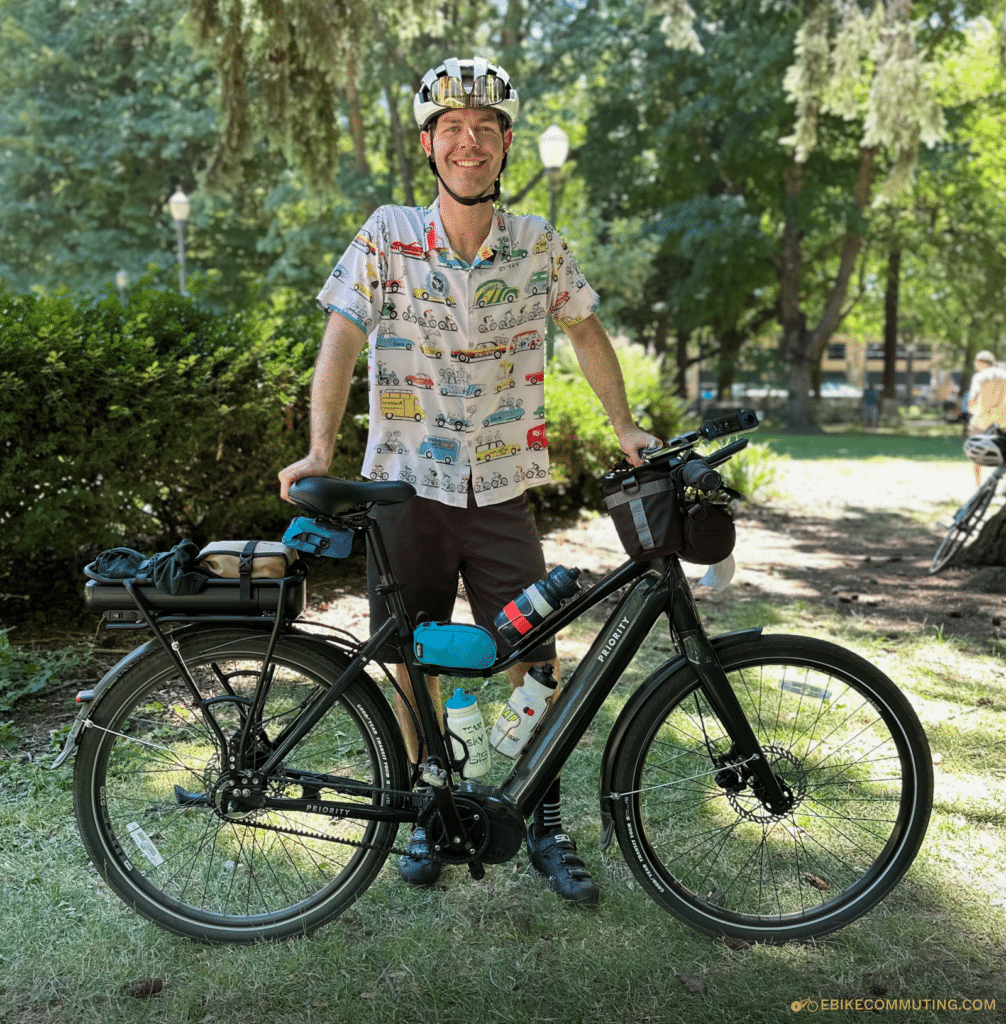
Day 1: Seattle, WA → Grand Mound, WA (104 miles)

Saturday morning started with a 4:30am wakeup.
I had two big concerns for the day. First, was battery anxiety. How good will the range on the Current actually be? Can I ride it on pedal assist level 2 or 3 and still have it get me to the mile 50 battery swap meeting point with Jody? The second was body anxiety. Will my legs hold up for the long ride? Will I have any pain that will force me to stop riding?
I got to the start line by 5:15am and was able to watch the one-day riders rollout. Rolling around the start area I noticed that my front brake was rubbing slightly. Conveniently Cascade had mechanic support at the start line and a mechanic from Montlake Bicycle Shop quickly adjusted my break so that it no longer rubbed.
I was lined up at the start by 5:25am and we rolled out on time at 5:30am. I was having some pre-ride jitters. Excited and nervous for the long day ahead of me, but the energy at the start line was positive and it kept me upbeat.
It was nice to get started in the front of the group since there are thousands of riders of all skill levels that tackle STP. Being near the front was where it seemed like the more experienced riders were so there was good communication between everyone riding to make the first few miles smooth.
The first five or six miles down to Lake Washington were probably the hardest for me because I quickly discovered that I hadn’t properly strapped everything to my e-bike. I had to stop three different times because something bounced off my e-bike, including my 360 camera that I ran over when it fell off. Again, another reason I should have taken the e-bike out for a long ride to really test out all my gear.
By mile 10 I got in a groove and settled down into a nice 20 mph on pedal assist level 2. My legs felt good and the sun was coming up. It was a perfect day for riding.
I began chatting with two guys (Ivan and Roberto) who had done STP before. I mentioned the e-bike to them because they hadn’t even noticed since the Current doesn’t scream e-bike and offered to let them draft behind me so they could conserve energy. They were ecstatic and hopped behind me.
People were loving the e-bike! As I cruised past people with Ivan and Roberto on my wheel they shouted at others to jump behind and get the e-bike power. 20 minutes later I looked behind and saw a big line of riders, must have been close to 20, drafting behind me. I kept the pace steady at 22 mph and we cruised along the first part of the day’s route, skipping the first rest stop in Puyallup at Mile 40 mile.
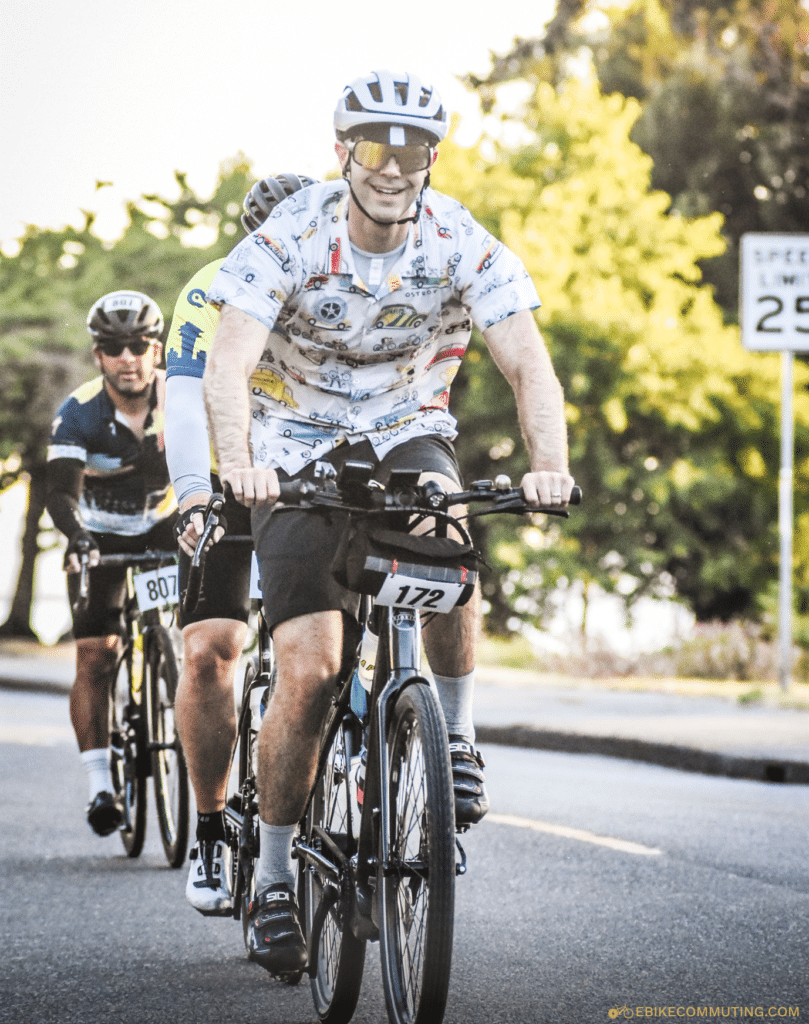
As we neared the big climb of the day (Mile 43) just before my battery swap meeting point (Mile 50) I was feeling much better about the range of the Current. The frame battery had lasted me to mile 28 while riding mostly on pedal assist level 2 and the e-bike had seamlessly swapped over to the range extender. As I hit the base of the climb at mile 43 I had about 50% left on the range extender and my legs were feeling good.
The climb was where the Current shined. I cruised past people on the climb. I was going so quickly that I actually turned down the pedal assist level from 3 to 2 so that I wouldn’t feel so bad for passing people so quickly. I heard a few grumbles from some guys who were clearly one day riders with their matching cycling team kits and shaved legs, but for the most part people didn’t pay me any mind.
Cresting the top of the hill I felt great and still had 1/3 of the range extender left. I was excited to reach the Spanaway Middle School rest stop so that I could use the porta-potty, refill my bottles and then go meet Jody.
It felt great to get off the e-bike, use the bathroom, and stretch my legs. I swapped out the batteries from Jody and jumped back on the e-bike. I was making great time and my spirits were high. Little did I know my fortunes would soon change.
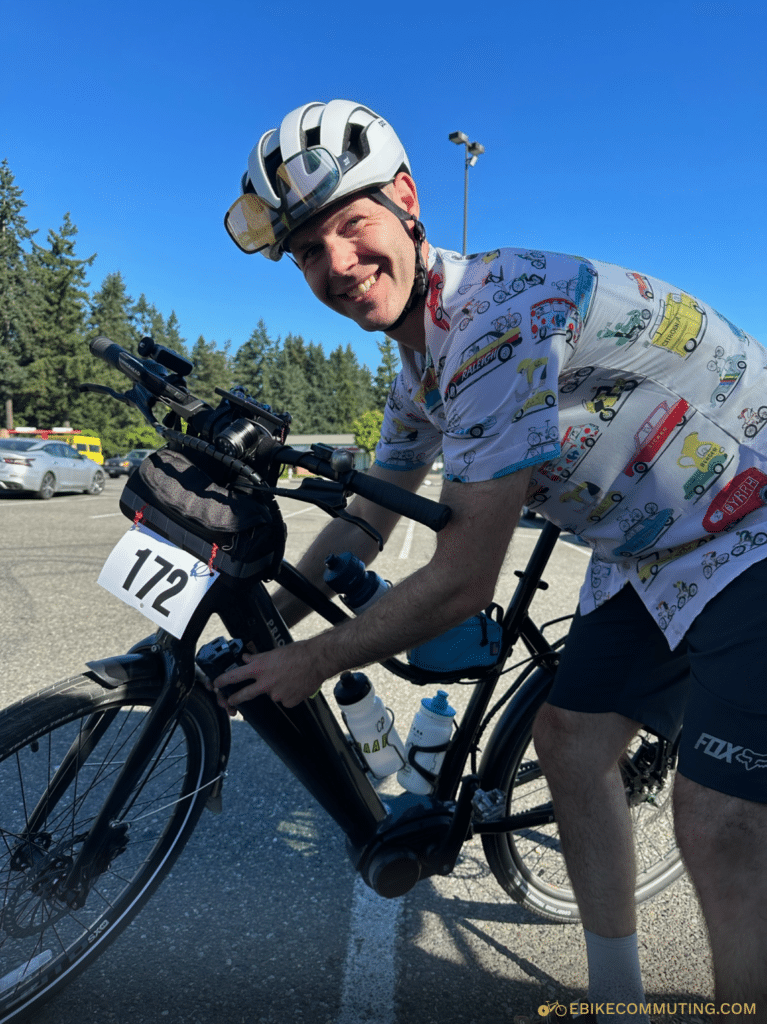
As I rode away from Jody in the Safeway parking lot, I noticed that the charge indicator for the frame battery showed only 80% charge. This was weird because I thought I had checked their charge level the day before the trip. It turns out that the charge indicator on the outside of the battery pack shows “fully charged” (4 out of 4 lights) when it’s actually still charging and not yet fully charged. I had unplugged it prematurely. Instead, I should have waited until the charger turned off.
I shrugged it off and kept riding, knowing that I still had the range extender. However, my battery anxiety was creeping back, so I turned down the pedal assist from level 3 to level 2 to conserve battery. This meant that I had to make my legs do more work, and as someone who had only ridden a maximum of 30 miles on a ride, fatigue was beginning to set in.
The riding was beautiful on this stretch of shaded forested highway. The road was straight and I was humming along on the Current with some train tracks off to my right.
At Mile 72, I passed through Yelm. My frame battery ran out of juice, and the current swapped over to the range extender. The charge indicator showed that the range extender was only 80% charged. I had made the same mistake with the range extender as I had with the frame battery by not fully charging it. This was a bit concerning, but I was still optimistic that I could make it to Grand Mound with the remaining charge.
I was making great time. It wasn’t even 10:30 am yet, and there were only 31 miles left to go. As I passed through the city of Yelm, I noticed some broken glass on the road. A group of riders was changing their road bike tires nearby. I grimaced at their misfortune and felt relieved that I was riding an e-bike with thick, puncture-resistant tires designed for city streets.
But then I noticed that my front tire was making a weird noise, and it felt like I had lost the ability to steer. Looking down, I realized that my front tire was flat. Ugh. It was 10:20 am.
Thankfully, I’ve changed a lot of tires in my cycling life, so I got my tools out and got to work. I inspected the tire and found a big piece of glass stuck in it. I removed it and then replaced the tube. But as I went to pump up the new tube, I realized that the hand pump that I brought, which I had briefly tested before I left, couldn’t actually inflate the tire with enough pressure to ride it. It was designed for a different type of tube than the one the Current uses.
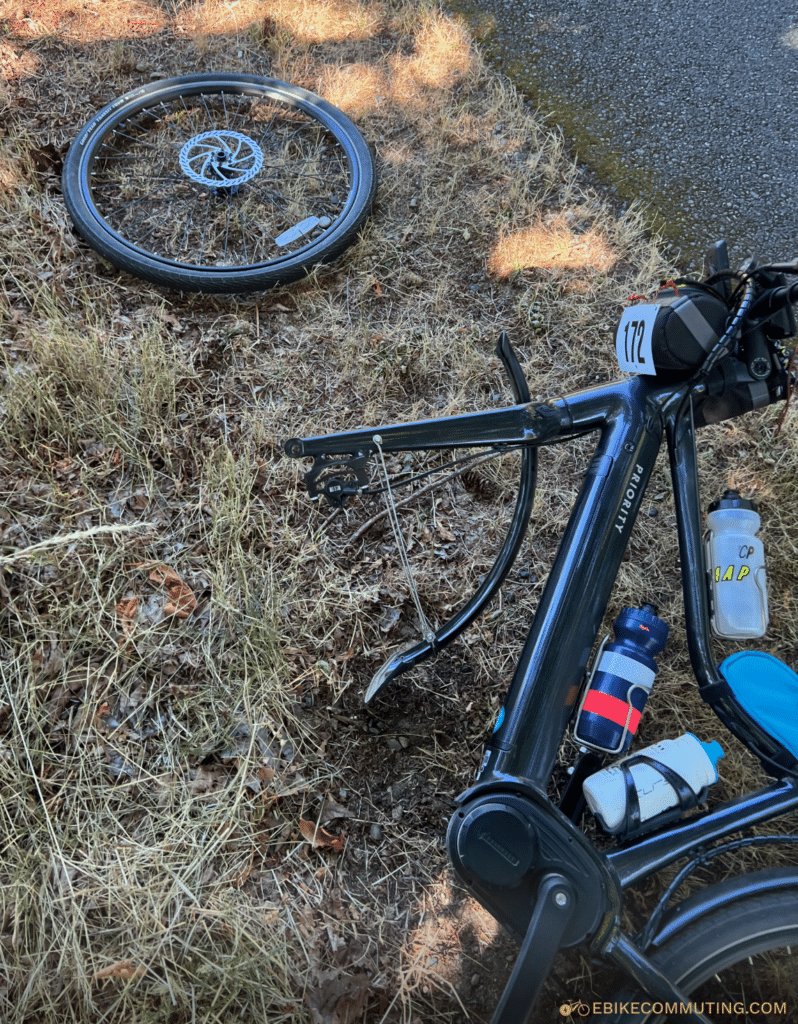
I began asking people riding by if they had a pump for the Schrader valve, but it is less common these days for cycling than the Presta valve and no one had the correct pump.
I called Cascade’s rider support line and spoke to the dispatcher. I explained my situation and sent them my GPS location. They put me on the mechanic list and told me to stay put. I proceeded to wait, but it took a while to get support because there are a lot of people riding the long route. Although it’s really nice that Cascade provides support along the way, I had to wait for about an hour. I found a partially shaded area near the road and sat down to wait.
Sitting on a rock in partial shade as the sun inched closer to me, and I waited for a mechanic to show up, was probably the low point of the whole ride. I was frustrated with myself for not properly checking the pump before I set off. I had hoped to arrive at the hotel and have lunch by 12 or 12:30 pm. However, it was already 11:45 am, and I was still waiting for a mechanic. I still had 29 miles to go.
The sun kept getting hotter and my shade kept shrinking.
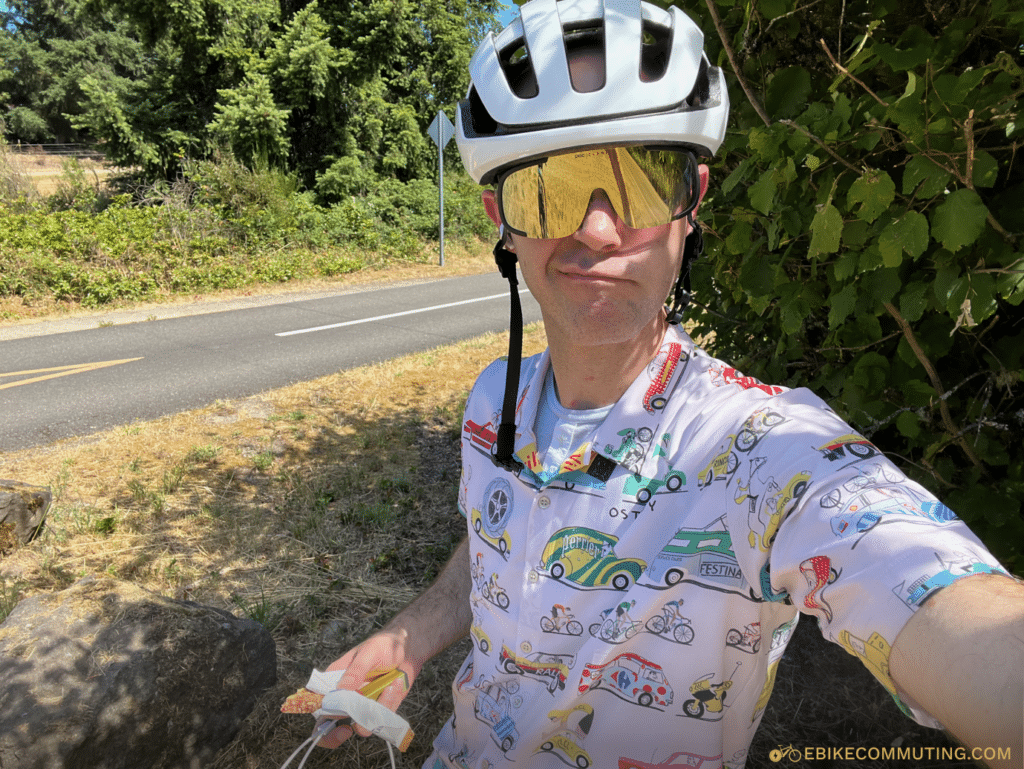
Finally, the Cascade support vehicle pulled up, and a friendly guy hopped out and shouted, “I’ve got your pump!” I quickly pumped up the tire, thanked him, and hit the road. I was frustrated that I was more than an hour behind schedule, but I felt better to be moving again.
Those last 29 miles were tough. I was hot, running low on water, and still annoyed that I had made a mistake with the pump. I tried to reset and focus on the positives, but it was tough.
Eventually, at 2:30 pm, I arrived at the hotel in Grand Mound, tired and hungry. I had been out on the course for 9 hours, almost double my original target of 5 hours.
The Current had held up well during the strenuous day, but I had not. My neck was sore, my left hand hurt, my legs were spent, and I felt very hot.
Thankfully, our hotel had great air conditioning, and Jody had bought me a salmon burger with fries from the local brewery. She had also gone to a bike shop in Centralia and bought me a spare tube, along with a pump that would actually pump up my tires. After having a recovery drink, taking a shower, eating some food, and lying down on the couch to watch some Tour de France highlights, I initially felt nauseous. However, after an hour of eating ice chips and lying down, my body felt better.
I had two batteries charging and was ready to swap them out for the other two before going to bed.
Day 1 was in the books, and I was starting to feel optimistic about Day 2.
Day 2: Grand Mound, WA → Portland, Oregon (111 miles)
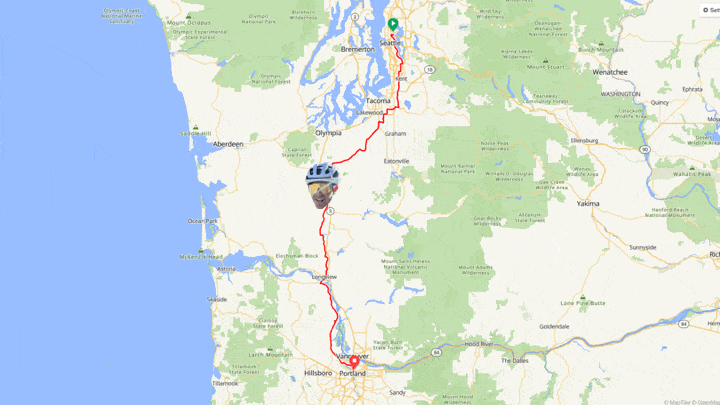
With my hotel being 4 miles off the course, Day 2 started with a 5:50am rollout and the first 4 miles on my own. The roads were quiet, I had full batteries, and the sun was just starting to rise over the hills.
My legs felt relatively recovered, but my butt was sore from sitting on the saddle for six hours the previous day. It was a bit uncomfortable at first, but I quickly got used to it. I also noticed that my left wrist and palm still hurt a bit, so I adjusted my hand position on the bars to try to alleviate some of the pressure.
As I linked up with the STP route in Centralia, I joined a steady stream of two-day riders. With the e-assist on the Current, I was able to easily maintain 18 to 20 mph, whereas the other riders were going closer to 13 or 15 mph. This meant I was constantly passing people on the quiet country roads from Centralia down to Castle Rock. I’m glad I had added a bell to my e-bike so that I could give a little ring every time I approached someone.
I skipped the first two rest stops in Winlock and Vader. Already, both were crowded with long bathroom lines and lots of people sitting down to eat an early morning snack. I had three water bottles on my bike, plenty of food, and felt like my legs were just getting warmed up, so I pushed on.
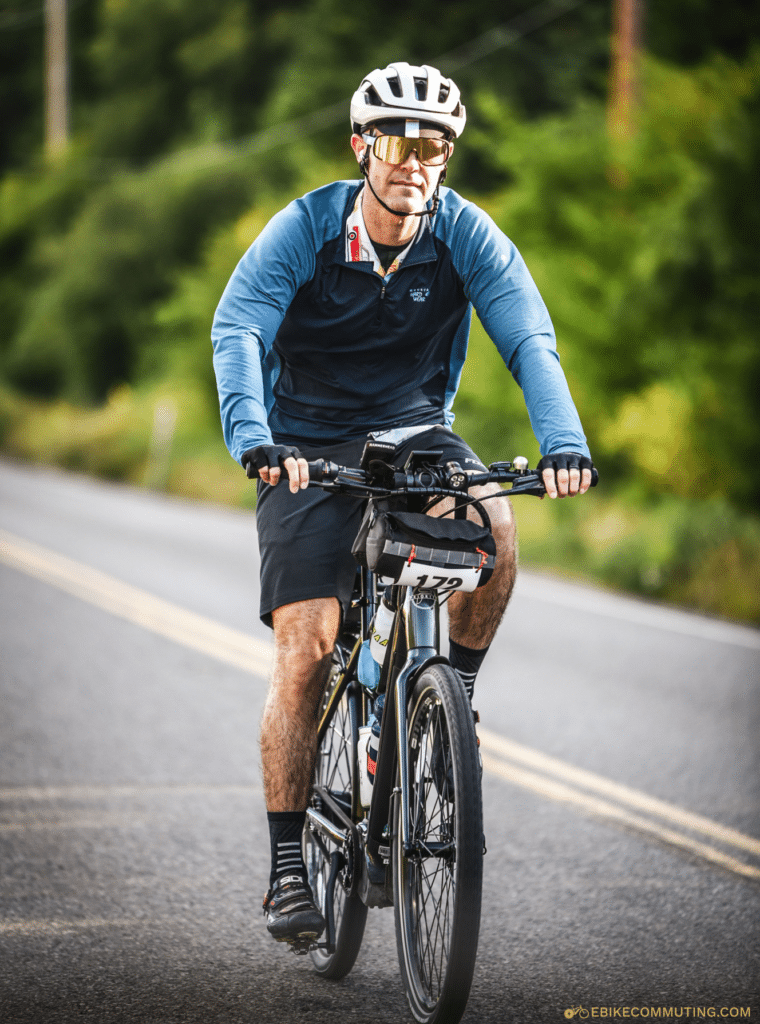
By the time I met up with Jody near Longview at Mile 60, I had only drained my frame battery and about half of the range extender. I was a bit surprised that I had so much charge left since I had been riding on pedal assist level 3 the entire morning.
We swapped out the batteries, I chugged some Starbucks coffee, reloaded my water bottles with Skratch Labs electrolytes, and hit the road. I was making good time and optimistic that I’d reach Portland by 1pm.
Just after Longview, the route crossed the Lewis and Clark bridge over the Columbia River into Portland. Due to the bridge’s high traffic, we were escorted in groups of about 100 riders. Fortunately, I arrived just as a group was departing, so I didn’t have to stop and wait like some others who reportedly waited for at least 20 minutes to cross.
Riding across the bridge was fun because the views of the logging mills were unique and it felt like we were getting close to Portland. I started at the very end of the group and used the e-assist to slowly pass riders on the way up to the crest of the bridge. By the time we were descending into Oregon, I was close to the front of the group.
As we passed the “Welcome to Oregon” sign, I was leading the group and pedaling hard. I felt great and was excited to be in Oregon.
For the next 20 miles, we followed the Columbia River, getting closer to Portland with each passing mile. As we approached the city, Highway 30 became increasingly busy with cars and trucks passing close to our bike lane. Since I was faster than the other riders, I had to frequently dart out into traffic to pass. This required me to constantly monitor the road behind me and time my efforts so that I could find a gap in the cars and avoid slowing down too much behind a group of riders. All of this required a lot more mental effort than I wanted to use after two days of riding my e-bike.
Thanks to better battery charging the previous night and swapping batteries at Mile 60, my frame battery still had a little bit of charge left by the time I stopped at the St. Helens rest stop at Mile 82. Feeling confident about my range, I left the Current on pedal assist level 3 for the remainder of the ride. I even bumped it up to level 4 on some sections of the highway when no other riders were around me. I was flying! At Mile 94, I made one final stop to refill my bottles before continuing on.
On the outskirts of Portland, we rode up and over St. John’s Bridge. It felt fantastic riding into the city, but when I looked down at my Hammerhead GPS unit, I saw that I still had 9 miles to go. That last stretch in the outskirts of Portland was painful. I was so close, yet there were traffic lights every block with red lights that I kept hitting.
Finally, at 1:15 pm, almost 7.5 hours after leaving the hotel in Grand Mound, I reached the finish line at Holladay Park. I crossed the line with a third of the range extender still left. I saw Jody cheering me on at the finish line and gave her a smile. It felt good to finish.

Closing thoughts
To answer the question that sparked this adventure: Yes, a commuter e-bike can cover over 200 miles in a weekend. I found that the Priority Current e-bike exceeded all my expectations. Its powerful 500-watt mid-drive motor and seamless belt drive offered an effortless riding experience, turning a grueling 215 mile ride into an enjoyable adventure and making me everyone’s favorite rider to draft behind. The Current is now, hands down, my favorite belt-drive e-bike! All of this made for a fun weekend.
When attempting STP ride on an e-bike, the biggest concern for most people is range anxiety. Based on my experience, I believe the Current’s advertised 100-mile range is achievable if you ride on pedal assist level 1 for the majority of the time. As I hadn’t trained for this ride, I rode on level 2 or 3. At that level, I estimate that you would have a range closer to 60 or 70 miles. Meeting Jody at the midpoint each day to swap out the batteries was crucial.
If you are planning to do STP on an e-bike unsupported and staying in group housing, I recommend including two batteries in your checked bag that you can pick up at the overnight point in Centralia. This means you won’t have to deal with charging your e-bike overnight. While Cascade provides battery chargers at the midpoint, there are a limited number of chargers, and they require that you keep your batteries on your bike while charging. This means you might not be sleeping near your bike, which I tend to avoid. One tip I heard from another e-biker is to pack an extension cord in your overnight bag so that you can find your own outlet and then run it over to your e-bike.
All in all, this was a fun adventure, and I would definitely do it again! Thank you to Cascade and Priority!
If you want to read my full review of the Priority Current, you can find it here.
Also, I made a Youtube video about the experience, watch it below.
